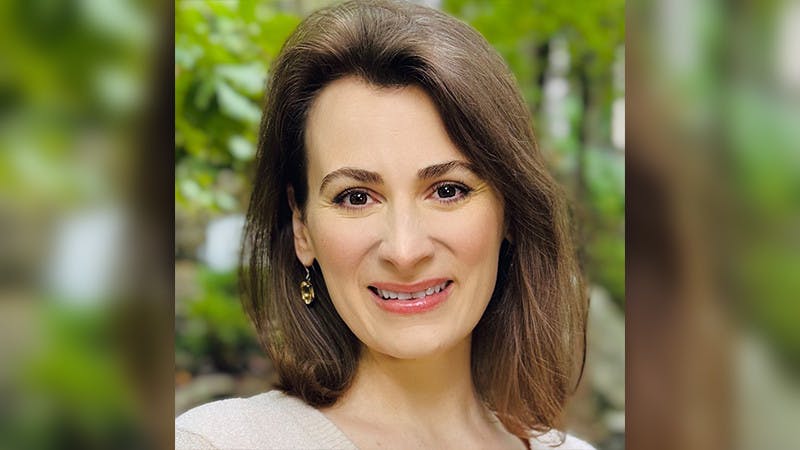
The Penn research team working with SEPTA on their rebranding efforts. Top row, from left to right: GM Leslie Richards, Camille Boggan, Lex Powers. Bottom row, from left to right: Will Herzog, Megan Ryerson. (Photo from Megan Ryerson)
A team of researchers from Penn’s Center for Safe Mobility is working with SEPTA on the transportation agency’s $40 million effort to rebrand its transit network and improve its ease of use.
Using data from eye-tracking glasses, Stuart Weitzman School of Design associate professor Megan Ryerson and her team of urban planners partnered with the transportation agency to determine which of the city’s stations were most confusing to riders of different transit familiarity, native languages, and physical abilities. The Center’s experimental study is part of SEPTA’s broader “Wayfinding” initiative to create a more intuitive transit system in response to complaints from riders about the lack of consistent branding and route signage. The Penn faculty and alumni involved in the study hope the rebranding changes the way Penn students think about SEPTA.
“We did this so that we can inform and redesign stations that really inspire confidence in a wide range of people,” Ryerson said.
The team began its data collection efforts in the spring of 2021 when they recruited local residents of diverse backgrounds to complete travel “missions” across the city using SEPTA buses, trolleys, and rail. Focusing their efforts at City Hall Station and the Erie and Broad Station at 3700 N. Broad Street, they instructed participants to travel to assigned destinations using a range of SEPTA routes.

People walk by SEPTA's 34th Street Station on Sept. 23.
As the riders traveled, they wore glasses that had the ability to record eye- and head-movement data up to 100 times per second. Twenty-five community members completed missions from City Hall, while another seven participated in the Broad and Erie missions, which focused on rail-bus connections.
“We were really able to find those 'pain points' as a person navigates through space. And then we were able to say to the team: ‘Look, when someone's at this location, they’re really stressed out. This is a place where you should put some reassuring signs,’” Ryerson explained.
Lex Powers, a 2015 Weitzman graduate and SEPTA’s strategic planning manager, said that accessible language is key to creating signage and wayfinding that is easy for everyone to understand.
After conducting a public survey and an audit of the system, SEPTA decided to change its signage so that lines would be identified by a single letter, square symbols, and a unique color. For example, the Broad Street Line will be indicated by a “B” with an orange background, the Market-Frankford Line by an “L” with a blue background, the Center City trolleys by a “T” with a green background, and the Route 15 trolley by a “G” with a yellow background.

SEPTA recently installed examples of the new signage at seven stations across the city and is currently undergoing a two-month feedback period. Will Herzog, a strategic planner for SEPTA who graduated from Weitzman in 2020, said that the public response to the rebranding has been largely positive.
Herzog, who was in charge of the community recruiting for Ryerson’s study, credited the success thus far to the diverse group of community members involved in the effort. The “Wayfinding” initiative has collaborated with the SEPTA Citizens Advisory Council, immigrant organizations, the Special Olympics, the SEPTA Youth Advisory Council, and university students, among others.
Powers and Herzog, who are both former students of Ryerson, had heard of her previous work with eye-tracking devices and thought that her expertise would apply well to SEPTA’s rebranding effort.
Ryerson ultimately identified three main ways in which SEPTA could improve its signage: promoting more consistent naming, ensuring there are signs at every station entrance, and installing more signs to reassure riders as they travel through stations.
Based on his own experience at Penn, Powers said many students don’t ride SEPTA even though it’s the most convenient way for Penn students to get into Center City and move around West Philadelphia.
“People sometimes feel that if you learn how to use SEPTA, it's like a life hack. It’s like you found the secret backdoor to the city," Powers said. “A minuscule percentage of people at Penn know that there are trolleys running in a tunnel underneath them. It's just crazy.”
In particular, Powers hopes to make the system accessible for students who can’t afford Ubers or Lyfts, as well as for international and non-local students who are unfamiliar with Philadelphia.
Mia Andersen, a College junior from London, agreed with Powers that SEPTA can be intimidating and challenging for students who are not from the area. When she first tried using SEPTA as a first year, Anderson said she “had not a clue what was going on” because there was no signage at the stops.
In London, where she used to take the Tube every day, she felt like there was more help for people unfamiliar with the city’s form of public transportation, whereas in Philadelphia, “you kind of have to figure it out on your own.”
Powers said full implementation of the rebranding will take about a year and SEPTA is still determining whether there will be a phased implementation or if all of the changes will occur at once.
Both Powers and Herzog emphasized that as they move through this feedback period, they encourage Penn students and all Philadelphia residents to submit any feedback they have about the new changes.
“There have been a lot of really enlightening comments that will allow us to further refine and produce a plan that is reflective of community needs,” Herzog said.
The Daily Pennsylvanian is an independent, student-run newspaper. Please consider making a donation to support the coverage that shapes the University. Your generosity ensures a future of strong journalism at Penn.
Donate





